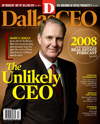It wasn’t so long ago when all you heard walking through downtown Dallas on a weekend was the echo of your footsteps. Now, those echoes are more muffled thanks to construction cranes, new retail stores, and real live people repopulating our urban core. The one thing critics have claimed would prevent downtown Dallas from coming back are the people who never left—the homeless. But, as the holidays fast approach and your giving spirit kicks in, it’s a good time to remember a new gift Dallas is giving itself in 2008 that will help solve this problem. That solution is not removing the homeless from downtown—but instead, truly helping the homeless.
The gift is the city’s new Homeless Assistance Center. Located between the south side of City Hall and the north side of Interstate 30 in downtown Dallas, the new center is scheduled to open in March or April of next year. According to a recent estimate, Dallas has somewhere between 5,000 and 6,000 homeless people. But the focus of the center will be on the 1,000 of them considered to be chronically homeless—those who have been homeless for at least a year, or four times in the past three years, and have either a physical disability, a diagnosable substance-abuse disorder, or a serious mental illness. They are the folks most nonprofit organizations currently aren’t equipped to work with.
“Our goal is to not duplicate services, but to fill a gap,” says Cindy Honey, executive director of the nonprofit Metro Dallas Homeless Alliance, which will contract with the city of Dallas to manage and oversee the facility. “These are people with disabilities. These are not lazy people. They are worn out, without hope, and many are confused to a level that they don’t know their way out.”
Offering much more than emergency overnight housing, the center will be a centralized entry point. Those who come will be assessed for mental and physical health and substance abuse and will be able to receive medical exams and other on-site assistance like legal support. The facility will provide showers, laundry, phones, computers, three meals a day, and a total of 100 indoor beds and up to 300 more in a safe, protected, open-air pavilion (conditions that some homeless people prefer). The program is based on what’s called a “housing first” model, and the name of the game is stabilization. “People cannot get over what brought them into long-term homelessness in three to five days,” says Honey. “Issues are best dealt with after they are housed.”
After an initial assessment and a few days at the center, MDHA will work with community service providers to place individuals in “permanent supportive housing”—safe, comfortable, permanent housing with case managers and support services attached. It’s something the MDHA is working to find more of. “We have a plan to end chronic homelessness by 2014. The Homeless Assistance Center is the first step of that plan,” says Mike Rawlings, Dallas’ homeless czar and chairman of the MDHA. “The services provided at the center will be world-class and (will) not only give the homeless the basic necessities they need, but … a way out of this cycle of hopelessness.”
Rawlings is managing partner of a Dallas private equity firm, a former president of Addison-based Pizza Hut and outgoing board chairman for the Dallas Convention and Visitors Bureau. He was appointed the city’s homeless czar by then-Mayor Laura Miller and recently reappointed by Mayor Tom Leppert. Both Rawlings and his predecessor, businessman and civic leader Tom Dunning, helped develop the concept of the center and, despite some calls to locate it as far away as Stemmons Freeway and Harry Hines Boulevard, fought hard to ensure it would be located downtown. The location, says Dunning, “is perfect, because you must build a facility where the greatest number of homeless are congregating, and that is in the downtown area.”
Dunning and Rawlings wisely knew that homeless people would not realistically get on a bus each day to be shipped to a more “convenient,” less attractive area that was not primed for major economic redevelopment. They also knew that other major metropolitan downtown areas had significant homeless populations—an issue that, while serious, did not prevent growth and revitalization. Think New York City, San Francisco, and Portland, Ore.
Rawlings calls the center a “jewel” for downtown Dallas. “The building will be far and away the best-looking building in that part of town,” he says. And, more than that, it may actually get people off the streets and into a safe place to live.
Crayton Webb is manager of government relations for Mary Kay Inc. Webb serves on the board of directors for the Dallas Convention & Visitors Bureau, Dallas Area Habitat for Humanity, the Greater Dallas Planning Council and the citywide fitness initiative, “Get A Move On.” Previously, he was chief of staff for Dallas Mayor Laura Miller and an investigative television news reporter for CBS 11.





